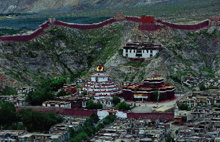Potala Palace
|

|
|
Palkhor Monastery. |
The palace is perched 3,770 meters above sea level on Marbori Mountain (or Red Mountain) in central Lhasa. It is the highest and largest palace complex on Earth. Potala means "the island where Avalokitesvara lives" in Sanskrit. Before 1959 the compound served as the residence and office of the Dalai Lamas, making it the heart of Tibet's theocracy. Since the 7th century it had been inhabited by nine Tibetan kings and 10 Dalai Lamas. The main buildings are the White Palace (the living quarters) in the east, and the Red Palace (comprising stupas of the Dalai Lamas and Buddhist shrines) in the center. The tall white-painted wall in front of the Red Palace is the Sunning Buddha Stage, where giant Buddhist paintings are hung during religious festivals. A panoramic view of the city can be seen from here. Potala Palace holds a wealth of antiques. Visitors have to book entry at the western gate of the palace one day in advance, entitling the purchaser to three tickets the next day.
Opening hours: 9:00 am - 4:00 pm
Admission: RMB 200 from May 1 to October 31, and RMB 100 from November 1 to April 30
Barkhor in the old district of Lhasa is a famous circumambulation path and commercial center. It is the area where the city's past is best preserved. Barkhor Street was originally a loop around Jokhang Monastery, but the name now refers to the whole old neighborhood surrounding the monastery.
Dating from the 15th century, Drepung Monastery on the western outskirts of Lhasa is the largest and highest ranked shrine of the Gelug Sect.
Opening hours: 9:00 am - 2:00 pm
Admission: RMB 45
Sera Monastery is known for the Buddhist doctrine debate among its monks, which commences at 3 pm every day.
Opening hours: 9:00 am - 4:00 pm
Admission: RMB 45
Ganden Monastery, 40 kilometers from Lhasa, was founded by Tsongkhapa, founder of the Gelug Sect, in 1409, and is therefore known as the origin of the Gelug Sect.
Opening hours: 9:00 am - 4:00 pm
Admission: RMB 40
